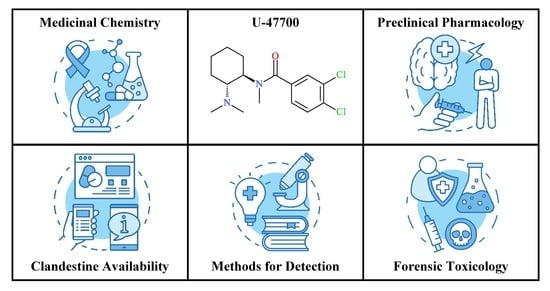Fertile
Bluelighter
- Joined
- Mar 31, 2022
- Messages
- 1,627

U-47700 and Its Analogs: Non-Fentanyl Synthetic Opioids Impacting the Recreational Drug Market
The recreational use of opioid drugs is a global threat to public health and safety. In particular, an epidemic of opioid overdose fatalities is being driven by illicitly manufactured fentanyl, while novel synthetic opioids (NSOs) are appearing on recreational drug markets as standalone...
In the 1960s a team at Allen and Hanbury developed AH-7921, a moderately potent opioid that had no practical advantages and so research was halted. In the 1970s and 1980s Dan Lednicer and Jacob Szmuszkovicz, members of Upjohn's drug discovery team further interrogated the QSAR and developed a number of more potent opioids with the unusual benzamide scaffold.
Of these, U-47700 (x7.5 morphine) & U-77891 (x75 morphine) are the most well known.
From the development numbers you can infer that MANY compounds were synthesized and tested. As further inroads were made into analysis of the QSAR of opioids, several modifications found to significantly increase the potency of related opioids were not known to the Upjohn team. What is interesting is that the benzamides developed by Upjohn has only 2 isomers. It is exceptional to find a compound as small as U-77891 with such a high potency. Generally it has been compounds bearing an N-2-arylethyl moiety that bind to an extra site that display such affinity.
In the case of U-77891 it would appear that the spacial relationship between the aromatic, oxygen lone-pair and basic nitrogen group and the rigidity of the molecule that have provided such affinity. This is quite a different approach to contemporary designs e.g. fentanyl.
A particularly valuable paper is:
'Factors affecting binding of trans-N-[2-(methylamino)cyclohexyl]benzamides at the primary morphine receptor
B. Vernon Cheney, Jacob Szmuszkovicz, Robert A. Lahti, and Dominic A. Zichi
J. Med. Chem. 1985, 28, 12, 1853–1864 Publication Date:December 1, 1985
The paper details and discusses:
-Pharmacology and Receptor Binding
-Drug Distribution Coefficients
-Molecular Geometry
-Key Features of Electronic Structure
This set of concepts are only seen in papers disclosed by the Upjohn drug discovery team and although more modern techniques exist, this methodology is facile for a decent researcher working with only limited assets.
I will draw your attention to the fact that R3 (the N-methyl of the benzamide moiety) overlays the 3-methyl of the prodine class of opioid precisely. Although the patents show that some alternative moieties were tested, the N-methyl proved to provide the highest affinity. Likewise the lone-pair of the amine moiety similarly overlay the nitrogen long-pair of the prodine class. Finally, the oxygen lone-pairs of the benzamide moiety are in the same special position and direction as the lone-pairs of the oxygen of the alcohol part of the ester moiety of prodine.
Put simply, although they might look totally unalike when viewed in 2D, U-47700 and β-prodine overly very closely indeed when inspected after energy minimization and as a 3D model. Thus it might be tentatively suggested that if one looks at later discoveries in the QSAR of the prodine class, it might well provide clues to the modification of the benzamide class to increase and/or modify activity.



